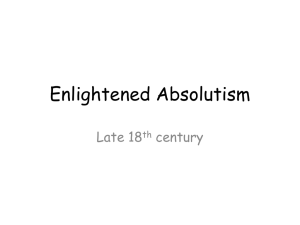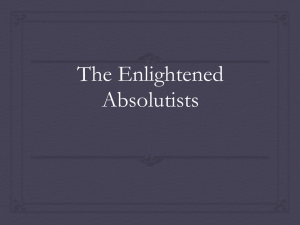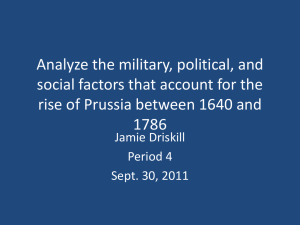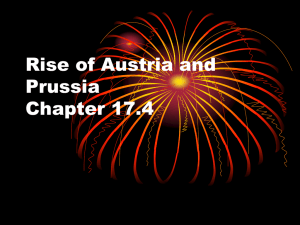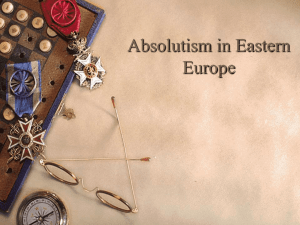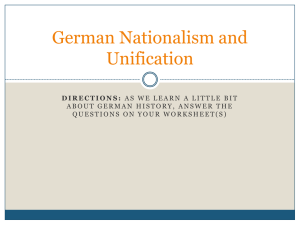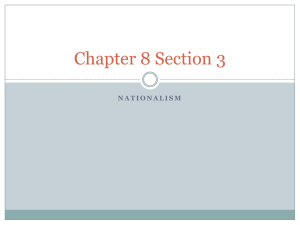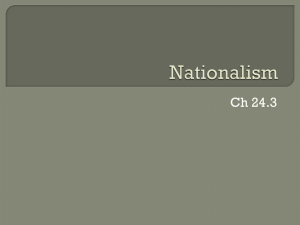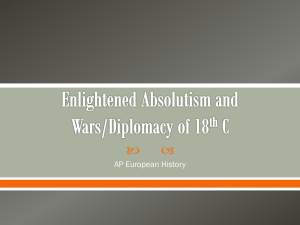maria theresa and the fredericks
advertisement
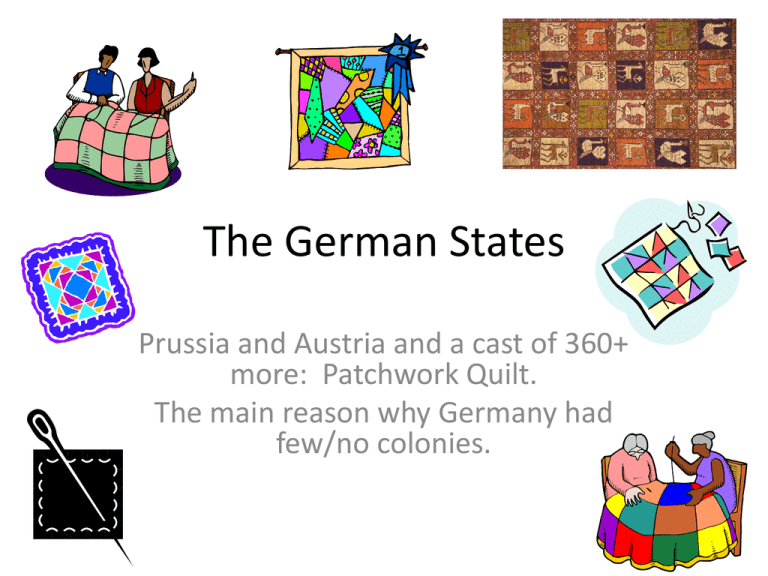
The German States Prussia and Austria and a cast of 360+ more: Patchwork Quilt. The main reason why Germany had few/no colonies. 4 Maintaining the Balance of Power By 1750, the great powers of Europe included Austria, Prussia, France, England, and Russia. These powers formed various alliances to maintain the balance of power. Though nations sometimes switched partners, two rivalries persisted. Prussia battled Austria for control of the German states. Britain and France competed for overseas empire. A major cause of the Thirty Years’ War was a conflict between Protestants and Catholics within the Holy Roman Empire. The Netherlands and the Holy Roman Empire were European powers were major rivals by 1750. Maria Theresa • Maria Theresa (13 May 1717 – 29 November 1780) was the only female ruler of the Habsburg dominions and the last of the House of Habsburg. She was 23 when she came to power. • She was the sovereign of Austria, Hungary, Croatia, Bohemia, Mantua, Milan, Lodomeria and Galicia, the Austrian Netherlands, and Parma. By marriage, she was Grand Duchess of Tuscany, Duchess of Lorraine, German Queen and Holy Roman Empress. • She became sovereign when her father, Emperor Charles VI, died in October 1740. Charles VI paved the way for her accession with the Pragmatic Sanction of 1713, as the Habsburg lands were bound by Salic law which prevented female succession. Upon the death of her father, Saxony, Prussia, Bavaria and France (the states of Europe that had previously recognized the sanction) repudiated it. Prussia proceeded to invade the affluent Habsburg province of Silesia, sparking an eight year long conflict known as the War of the Austrian Succession. • Maria Theresa promulgated financial and educational reforms, with the assistance of Count Friedrich Wilhelm von Haugwitz and Gottfried van Swieten, promoted commerce and the development of agriculture, and reorganized the Austria's ramshackle military, all of which strengthened Austria's international standing, but refused to allow religious toleration. Pragmatic Sanction… • Maria Theresa being crowned King of Hungary, St. Martin's Cathedral. Religious Tolerance… • Like all members of the House of Habsburg, Maria Theresa was a Roman Catholic, and a devout one as well. She believed that religious unity was necessary for a peaceful public life and explicitly rejected the idea of religious toleration. However, she never allowed the Church to interfere with what she considered to be prerogatives of a monarch and kept Rome at arm's length. She controlled the selection of archbishops, bishops and abbots. • Her approach to religious piety differed from the approach of her predecessors. The empress actively supported conversion to Roman Catholicism by securing pensions to the converts. She tolerated Greek Catholics and emphasized their equal status with Roman Catholics • Besides her devotion to Christianity, she was widely known for her ascetic lifestyle, especially during her 15-year-long widowhood. Though she eventually gave up trying to convert her non-Catholic subjects to Roman Catholicism. • Though she was expected to cede power to her husband or son, both of whom were officially her co-rulers in Austria and Bohemia, Maria Theresa was the absolute sovereign of her dominions. She criticized and disapproved of many of Joseph's (son’s) actions. She vehemently resisted the First Partition of Poland, but Joseph and her Chancellor, Prince Kaunitz forced her to authorize it. Maria Theresa oversaw the unification of the Austrian and Bohemian chancellories. • She had 16 children by Francis I, Holy Roman Emperor, including a queen of France, a queen of Naples, a duchess of Parma and two Holy Roman Emperors. • Maria Theresa possessed qualities appreciated in a monarch: warm heart, practical mind, firm determination, sound perception, and, most importantly, readiness to acknowledge mental superiority of her advisers. • As a young monarch who had to fight two dynastic wars, she believed that her cause should be the cause of her subjects, but in her later years she came to understand that their cause must be hers. • Maria Theresa regarded both the Jews and Protestants as dangerous to the state and actively tried to suppress them. The empress was probably the most anti-Semitic monarch of her day, having inherited all traditional prejudices of her ancestors and acquired new ones. This highly personal feature was a product of deep religious devotion and was not kept secret in her time. • In 1777, she wrote of the Jews: • “I know of no greater plague than this race, which on account of its deceit, usury and avarice is driving my subjects into beggary. Therefore as far as possible, the Jews are to be kept away and avoided”. • She imposed extremely harsh taxes on her Jewish subjects and, in December 1744, she proposed expelling the Jews from her hereditary dominions to her ministers. Her first intention was to expel all Jews by 1 January, but accepted the advice of her ministers who were concerned by the number of future expellees and had them expelled by June. She also transferred Protestants from Austria to Transylvania and cut down the number of religious holidays and monastic orders. In 1701 the title of King in Prussia was granted, without the Duchy of Prussia being elevated to a Kingdom within the Holy Roman Empire. From 1701 onwards the titles of Duke of Prussia and Elector of Brandenburg were always attached to the title of King in Prussia. Kings in Prussia 1701–1713: Frederick I/II/IV (also Duke of Prussia and Elector of Brandenburg) 1713–1740: Frederick William I (son of) 1740–1786: Frederick II the Great (son of, later also King of Prussia) In 1772 the Duchy of Prussia was elevated to a kingdom. Kings of Prussia (1772–1918) Kaiser=caesar Kingdom of Prussia in 1815. In 1772 the title of King of Prussia was granted with the establishment of the Kingdom of Prussia. From 1772 onwards the titles of Duke of Prussia and Elector of Brandenburg were always attached to the title of King of Prussia. Frederick II the Great (1740–1786) (son of, before King in Prussia) Frederick William II(1786–1797) (nephew of) Frederick William III (1797–1840) (son of) Frederick William IV (1840–1861) (son of) Wilhelm I (1861–1888) (brother of) Frederick III (1888) (son of) Wilhelm II (1888–1918) (son of) responsible for World War I The Kingdom of Prussia at the time of the formation of the German Confederation (1818) with provincial borders. The Prussian province of Brandenburg (red), within the Kingdom of Prussia (blue). Frederick William—The Great Elector • After the Thirty Years’ War he increased power of BrandenburgPrussia • Created a standing army • Wooed the Junkers (the nobles) by giving them special tax breaks, landownership, power over the peasants, etc. • He gained absolute power with this Junker alliance. Friedrich I Preußen Prussian Royalty House of Hohenzollern Helped the Austrian Habsburgs against France in the War of the Spanish Succession. He received title of king, but was a weak, ineffective ruler. Nice hair, though! Frederick William I • Centralized the Prussian government • Brought in revenue and supported production and trade • Whipped the army into efficient fighting machine • Known as the “Royal Drill Sergeant” or the Soldier King • Liked his recruits tall—hmmmm…. a special regiment nicknamed the Potsdam Giants. Prussia and Austria do not get along! • Maria Theresa's lifetime enemy, King Frederick II of Prussia, to whom she referred as "that evil man", by Antoine Pesne. He always referred to her with the male pronoun “He.” Frederick William II • Aka Frederick the Great—loved music, art, horses, and military stuff. • Rejected Austria’s pragmatic sanction and seized Silesia—sparked the War of the Austrian Succession. Spain and France backed Prussia. • They emerged as a power! • Austria gained support of Russia—and moved into The Seven Years’ War—to get Silesia back! • Everyone got in on it—globally. French and Indian War was North America’s part of it. France loses everything— Great Britain became world #1, and Prussia still kept Silesia. 4 The Thirty Years’ War CAUSES Rival German princes held more power than the Holy Roman Emperor. Religion divided the Protestant north and the Catholic south and created a power vacuum. RESULTS The Peace of Westphalia ended the war with a general European peace. The war led to severe depopulation. France gained territory. The Hapsburgs were forced to accept independence of all of the princes of the Holy Roman Empire. Germany was divided into more than 360 states. The Netherlands and present-day Switzerland won independence. Europe after the Peace of Westphalia ended the Thirty Years’ War in 1648. 4 Europe After the Thirty Years’ War 4 Two great empires, Austria and Prussia, rose out of the ashes of the Thirty Years’ War. AUSTRIA The Hapsburgs kept the title of Holy Roman emperors and expanded their lands. Hapsburg monarchs worked hard to unite the empire, which included peoples from many backgrounds and cultures. Maria Theresa won popular support and strengthened Hapsburg power by reorganizing the bureaucracy and improving tax collection. PRUSSIA The Hohenzollern family united their lands by taking over the states between them. Hohenzollern kings set up an efficient central bureaucracy and reduced the independence of nobles. Frederick William I created one of the best armies in Europe. Frederick II used the army to strengthen Prussia. Johann Sebastian Bach • Kappellmeister—Lutheran • Baroque music—lively, complex and dramatic. • Used counterpoint and fugue—blending and variations • Work neglected for 50 years, but appreciated now. • His music is magnificent!
